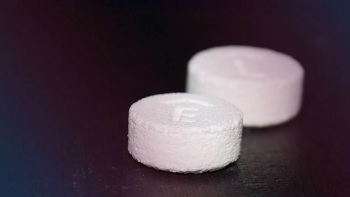 |
| Aprecia's Spritam tablets, quickly dissolvable in liquid--Courtesy of Aprecia |
The FDA on Monday approved Aprecia Pharmaceuticals' Spritam, which is the first 3-D printed product designed for use in the human body. The drug is intended to treat epileptic seizures, and its MIT-created delivery platform allows for oral administration in the form of a small tablet that dissolves quickly in liquid due to its porous nature.
Pennsylvania-based Aprecia--which operates a former Forest Laboratories plant in Ohio--gained the exclusive license to 3-D printing technology from MIT in the late 1980s, and by 2007 it began developing its ZipDose platform for drug delivery, an orodispersible structure that allows for easy-to-swallow tablets. It submitted its first NDA last October.
The new drug Spritam, designated to treat epilepsy, is a formulation of the commonly prescribed levetiracetam. Because of its rapid disintegration with a sip of liquid, it can deliver a high drug load of up to 1,000 mg in a single dose while at the same time conforming to the needs of patients with trouble swallowing, often small children. The company said it expects the product to be available in next year's first quarter.
The 3-D printing is a crucial part of the manufacturing process, in which layer upon layer of a powdered form of the drug form small tablets, a structure that gives it such a high degree of dissolvability in liquid. Also, because it is made entirely from the powdered drug, each pill has a uniform (and thus predictable) dose, especially important in a drug intended for the central nervous system.
"By combining (3-D printing) technology with a highly-prescribed epilepsy treatment, Spritam is designed to fill a need for patients who struggle with their current medication experience," Aprecia CEO Don Wetherhold said in a statement. "This is the first in a line of central nervous system products Aprecia plans to introduce as part of our commitment to transform the way patients experience taking medication."
- here's the release (PDF)